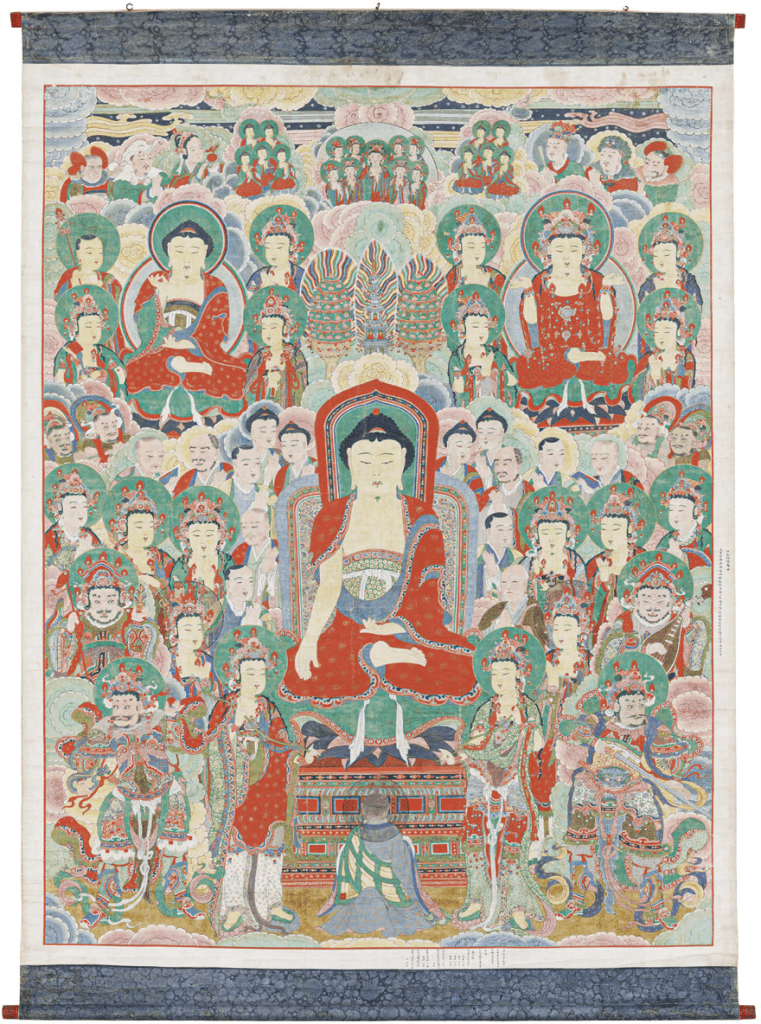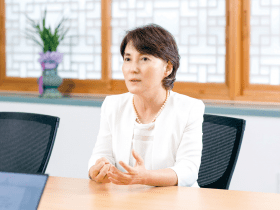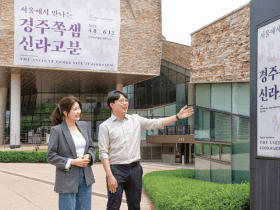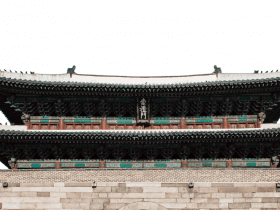Research Division of Artistic Heritage
Park, Yoonhee


There is a Korean word, yadan beopseok, which describes a fussy and noisy situation. In fact, this word came from a Buddhist term as when monks held an outdoor Buddhist service to preach Buddhist sermons, many people gathered and created a fuss, which was called yadan beopseok. Gwaebul, or a large Buddhist hanging scroll, was hung during the yadan beopseok.
Such Buddhist paintings were produced in an enormous size so anyone who attended the Buddhist service could see them. Recently, high-resolution digital images of gwaebul were released online at NRICH Research Portal. We sat down with researcher Park, Yoonhee of the Research Division of Artistic Heritage at the NRICH, who organized the project, to talk about gwaebul.
Q. What is gwaebul?
Gwaebul is a type of Buddhist painting produced for outdoor Buddhist rituals during the Joseon Dynasty. The hanging scrolls generally reach up to 10 meters since it was for outdoor ceremonies attracting many people, such as Buddha’s Birthday, Yeongsanjae (Korean Buddhist ceremony reenacting Buddha’s delivery of the Lotus Sutra), and Cheondojae (Buddhist ritual for the deceased). Since there were so many people and it was impossible for the Buddhist temple halls to accommodate all the people, those outside the building could participate in the rite by watching the Buddhist painting hanging outside the Buddhist sanctuary. It can be understood as a way to share the Buddha’s mercy and merit with more people.
It would not have been easy to paint such a large painting. Is it painted by a single person?
No. Gwaebul is a painting drawn elaborately by several hwaseung, or monk-painters. It was a large-scale Buddhist affair, and a veteran head monk-painter led the co-production with several assistant painters and each person drew one’s own part. Through these collaborations, a unique style of painting could be handed down in each region. If the gwaebul is worn and discolored after a long time, other monk-painters carefully repaired it to the extent that it did not harm the original style.


Q. Is there any information left about the year when the gwaebul was produced and the person who drew it?
The painting’s chronicle was written at the bottom of the painting, and it included a wide range of information such the year of production and the list of people who took part in the Buddhist affair from the monk-painters to those who donated for the painting. Research on Buddhist painting history as well as temple history and Buddhist rituals is conducted based on the painting’s chronicle.
Since gwaebul is quite big, it would not have been easy to produce and store the Buddhist hanging scrolls. What temple made gwaebul and how did the monks keep it?
Due to its large size, it costed a lot to produce a gwaebul. Therefore, gwaebul was produced among temples with a long history or large and powerful temples. In case of temples in Gyeonggi Province, many large-scale Buddhist paintings belong to royal votive shrines, called wondang, to pray for happiness of deceased kings and queens in the afterlife, which suggests that the gwaebul was made to pray for the souls of royal figures. Since the gwaebul was made in the form of a hanging scroll, it was usually rolled, placed in a pine tree box and stored behind the Buddhist altar in the temple. It was moved outside to be hung during outdoor Buddhist service.


Q. Since when gwaebul was painted and what is the reason for painting gwaebul?
The origin of gwaebul is not known exactly. We only presume that it was created after the Imjin War, or 1592–1598 Japanese invasions of Korea, and the Byeongja War, or the 1636-1637 Manchu Invasion of Korea, as there were large-scale rituals to soothe the souls of the dead. As the nation suffered from disasters, the rituals to console the souls were held at Buddhist temples to pray for those who died of war and starvation and to comfort the sick people; this is presumed to be the beginning of gwaebul.
Q. What is the significance of gwaebul in Korea’s art history?
Gwaebul is an essence of Buddhist art and faith. Gwaebul is known for its overwhelming size as well as bright colors and intricate descriptions. That is why we consider gwaebul as a major art heritage that showcases the development of Korean Buddhist faith and art. It has an originality that cannot be found anywhere else in the world and that is why gwaebul is designated as state-designated heritage Treasure for conservation and management.
Q. Since when and how did the research on gwaebul take place?
The Research Division of Artistic Heritage at the NRICH began research on gwaebul in full swing and conducted investigation on 53 large Buddhist hanging scrolls in Korean temples from 1985 to 2001. This long-term project provided basic data for Buddhist painting in Korea and discovered the cultural value of gwaebul. It led gwaebul to become the state-designated heritage.
Q. Is the research on gwaebul still going on?
Of course. The NRICH is conducting the “In-depth Research Project of Large Buddhist Paintings” from 2015 to 2024 with the Conservation Science Division of the NRICH and the Research Institute of Sungbo Cultural Heritage, including scientific investigations such as analysis on coloring pigments and other materials used to produce gwaebul. To promote the artistic value of gwaebul to the public, the Research Division of Artistic Heritage unveiled the high-resolution gwaebul image database this year.
Q. Where can I see the high-definition images of gwaebul?
It can be found at the NRICH Research Portal (https://portal.nrich.go.kr) under the “Gwaebul of Korea” gallery menu. We unveiled high-resolution images of 47 gwaebuls this year in the first phase and will continue to release more phots as the project progresses. The high-definition photos available from the gallery are at least 30 million pixels up to 60 million, allowing the viewers to see the full view as well as detailed patterns magnified. I hope you can see the beauty of gwaebul, which was painted with sincerity and devotion by painter-monks of the Joseon Dynasty.


https://portal.nrich.go.kr/kor/buddhaNdGallery.do?menuIdx=1092


Q. Do you have any plans for future gwaebul research?
The NRICH has recently conducted scientific research for efficient conservation and management of gwaebul. Starting this year, we are preparing to publish a catalog examining formative characteristics of Korean gwaebul combining art historical analysis perspective with the data accumulated by scientific research. This would provide an opportunity to understand the formative characteristics of gwaebul from the Joseon era, which has aesthetics different from Goryeo-era, and take a step closer to Buddhist painting, which has been considered difficult.







